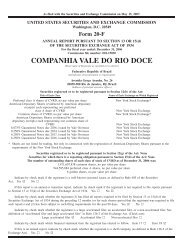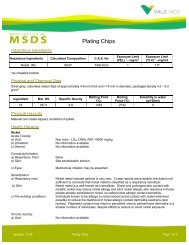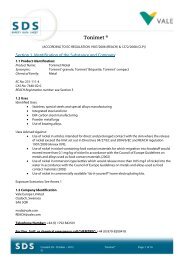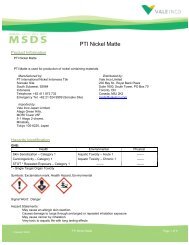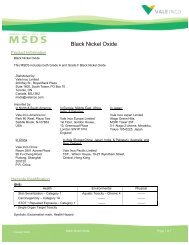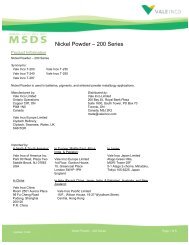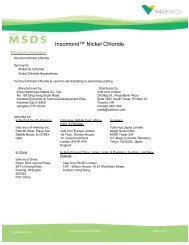Vale Inco Black Nickel Oxide - Vale.com
Vale Inco Black Nickel Oxide - Vale.com
Vale Inco Black Nickel Oxide - Vale.com
- No tags were found...
You also want an ePaper? Increase the reach of your titles
YUMPU automatically turns print PDFs into web optimized ePapers that Google loves.
<strong>Vale</strong> <strong>Inco</strong> <strong>Black</strong> <strong>Nickel</strong> <strong>Oxide</strong>This MSDS covers the family of products identified as <strong>Vale</strong> <strong>Inco</strong> <strong>Black</strong> <strong>Nickel</strong> <strong>Oxide</strong>. This includes the following grades:Grade A, Grade F.Product Information<strong>Vale</strong> <strong>Inco</strong> High Purity <strong>Black</strong> <strong>Nickel</strong> <strong>Oxide</strong>Distributed By:<strong>Vale</strong> <strong>Inco</strong> Limited200 Bay Street, Royal Bank PlazaSuite 1600, South Tower, P.O. Box 70Toronto, Ontario, Canada M5J 2K2Chemtrec 24 hr Emergency No. 1-800-424-9300Manufactured by:Seido Chemical Industry Co., Ltd.2-1-26, Kitahama, Chuo-kuOsaka, Japan541-0041High Purity <strong>Black</strong> <strong>Nickel</strong> <strong>Oxide</strong> is used in electroplating, alloying, enameling and as an intermediate in the production ofother <strong>com</strong>pounds.Hazardous IngredientsHazardous Ingredients Calculated Composition C.A.S. NoExposure Limit(TLV) 1,2 –mg/m 3<strong>Nickel</strong> <strong>Oxide</strong> (NiO) 95-100 1313-99-1 0.2* as Ni<strong>Nickel</strong> Hydroxide (Ni(OH) 2 ) 5000 mg/kgUpdated: 03/06<strong>Black</strong> <strong>Nickel</strong> <strong>Oxide</strong> Page 1 of 3
Inhalation:Evidence for the association of nickel <strong>com</strong>pound exposures and cancer risk <strong>com</strong>esmainly from workers in now obsolete nickel refining operations. The studies of nickelworkers suggest that respiratory cancer risks are primarily related to exposure torelatively insoluble forms of nickel notably sulphidic and oxidic nickel at concentrationsgreater than 10mg/m3. Toxic respiratory effects in animals may be caused by reducedparticle clearance capacity.The International Agency for Research on Cancer (IARC) (ref. 4) in 1990 and the U.S.Tenth Report on Carcinogens (ref. 5) in 2002 concluded there was sufficient evidencethat nickel <strong>com</strong>pounds are carcinogenic to humans. The Report of the InternationalCommittee on <strong>Nickel</strong> Carcinogenesis in Man reported that workers who have beenprimarily exposed to nickel oxide showed some evidence of increased lung cancer.The European Union Commission in 1991 classified nickel oxide and work involvingexposure to dusts, fumes and sprays produced during the roasting and electrorefining ofnickel-copper mattes as carcinogenic processes.ACGIH has re-evaluated the data regarding the carcinogenicity of nickel and nickel<strong>com</strong>pounds and has classified nickel oxide as a confirmed human carcinogen, Class A1.There is some evidence that the inhalation of nickel oxide has resulted in an increasedincidence of malignant lung tumors in rats. Inhalation of nickel oxide at concentrations 50times the TLV, produced pneumoconiosis in hamsters. Repeated intratracheal instillationof nickel oxide produced an increased incidence of malignant lung tumors in rats.Wounds:Ingestion:Preexisting Conditions:Reproductive Toxicity:<strong>Nickel</strong> Hydroxide<strong>Nickel</strong> oxide has caused tumors at the site of injection in rodents.The U.S. National Institute for Occupational Safety and Health (NIOSH) concluded thereis no evidence that nickel and its inorganic <strong>com</strong>pounds are carcinogenic when ingested.The U.S. Food and Drug Administration has affirmed that nickel is generally recognizedas safe (GRAS) as a direct human food ingredient.Prolonged and intimate skin contact can cause an allergic skin rash in previouslysensitized individuals.There is no evidence of mutagenesis. Animal experiments indicate that soluble nickelingestion causes adverse effects on fetal development at a threshold oral exposure of 2.2mg/Ni/kg/day by pregnant rats. Data are insufficient to determine if this effect occurs inhumans and no regulatory agency has classified soluble forms of nickel as reproductiverisks for humans.No information currently available.Preventative MeasuresDo not inhale powder. Keep container closed when not in use. Ventilation is normally required when handling or using thisproduct to keep exposure to airborne nickel oxide below the exposure limit. If ventilation alone cannot so controlUpdated: 03/06<strong>Black</strong> <strong>Nickel</strong> <strong>Oxide</strong> Page 2 of 3
exposure, use NIOSH-approved respirators selected according to the current edition of the Selection, Care and Use ofRespirators CSA Z94.4. Maintain the airborne nickel levels as low as possible.If spilled, collect spills by wet sweeping or by vacuuming and pass the vacuum exhaust through a high efficiencyparticulate arresting (HEPA) filter if the exhaust is discharged into the workplace. Wear appropriate NIOSH-approvedrespirators if collection and disposal of spills is likely to cause the concentration of airborne contaminants to exceed theexposure limits.<strong>Nickel</strong>-containing waste is normally collected to recover nickel values. Should waste disposal be deemed necessary,follow the relevant governmental regulations.First Aid MeasuresFor inhalation irritation, move to fresh air and seek medical attention. For skin irritation, wash skin thoroughly with plentyof water; seek medical attention. For eye contact, immediately flush eyeballs with plenty of water; seek medical attention.Cleanse wounds thoroughly to remove any particles.Preparation InformationPrepared by:<strong>Vale</strong> <strong>Inco</strong> Limited200 Bay St., Royal Bank PlazaSuite 1600, South Tower, PO Box 70Toronto, Ontario, Canada, M5J 2K2Product Stewardship (416) 361-7801MSDS available online at www.valeinco.<strong>com</strong>msds@valeinco.<strong>com</strong>Note:<strong>Vale</strong> <strong>Inco</strong> believes that the information in this Material Safety Data Sheet is accurate. However, <strong>Vale</strong> <strong>Inco</strong> makes no express orimplied warranty as to the accuracy of such information and expressly disclaims any liability resulting from reliance on suchinformation.Footnotes:1 Threshold Limit Value of the American Conference of Governmental Industrial Hygienists.2 Exposure Limits for user operations will depend on the relevant governmental regulations.3 Describes possible health hazards of the product supplied. If user operations change it to other chemical forms, whether as endproducts, intermediates or fugitive emissions, the possible health hazards of such forms must be determined by the user.Updated: 03/06<strong>Black</strong> <strong>Nickel</strong> <strong>Oxide</strong> Page 3 of 3



